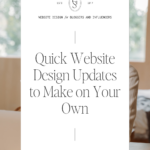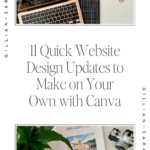
Quick Website Design Updates to Make on Your Own
Table of Contents
ToggleSharing is caring!
Reading Time: 4 minutes


When was the last time you updated your website design? No matter how beautiful your website is, it’s important to tweak the design regularly to attract more readers and improve user experience. You’ll get a positive first impression from new readers, boosts interest from regular readers, and develop a stronger online presence by making quick design updates on your website once or twice a year.
According to Pixolabo, 23% of small business websites get updated at least once in less than a year. The updates do not have to be extensive, and you don’t have to hire a professional to do this for you. Apps like Canva let you create beautiful site visuals with just a few clicks.
With Canva, you don’t have to hire a professional graphic designer to create all types of visual content, including images for a refreshed website design. Now that you know the beauty of Canva, let’s look at ways to update your website design for better results.

11 Quick Website Design Updates to Make on Your Own
Include your name
Use your name as your business name to connect more deeply with your target audience. Adding your name to your website only takes a few seconds. You can include your name on your homepage, About Us, and Contact Us pages.
Add your photo to your website
Give your business a face that people can relate to. Adding your image boosts credibility and trust. Showing a picture of yourself demonstrates honesty, and people will get the impression that you have nothing to hide, increasing trustworthiness. You don’t have to hire a professional for a photo shoot; you can take photos of yourself and feature them on your blog posts, website design, and social media pages.
Show off your social proof
Letting your clients know exactly what previous clients think about you and your business via positive feedback helps build trust. Testimonials and client feedback add confidence to your business. These also help potential clients understand what your business can do for them. You can use Canva’s premade templates to copy and paste several testimonials and post them on your website. You can also post these images on your social media pages to let people know how amazing it is to work with you!
Show off your best offers
Your best offers could attract potential clients. If you’re selling an online course, a digital product, or any freebie, put that offer on your homepage for maximum exposure. This way, potential clients do not have to dig too deeply into your website to find your primary product. If you’re selling multiple products, outlining them on a list could confuse or overwhelm them. Focus on one offer – the main thing that people buy from you.
Remove a discovery call option on your website
This option is convenient for people who are 100% sure about buying from you. But the fact is, not all people who go to your website need the product or service you offer. And most of these people aren’t looking to book a call with you.
Don’t focus your energy too much on discovery calls because these will only eat a huge chunk of your time. Instead, develop a pre-qualification system to filter potential clients and non-interested readers instead of letting everyone who visits your website book a call. With a pre-qualification system, identifying your ideal client will be much easier.
Add social media buttons
If you haven’t added social media buttons on your homepage and every blog post already, now’s a good time to do it. Adding these social buttons makes it easier for readers to follow your updates on all social media platforms you use. This will help strengthen your online presence, grow your reach, and build a trusted brand. On your homepage, put the social media buttons on the header or footer. For every blog post, you can set it right below the title or at the bottom of the post.
Add maps and business hours
If you have a physical store or an office, it’s vital to add an interactive map to know where to find your business. Include the business hours so customers know when to contact you. For strictly digital stores, you can post your business hours.
Improve the navigation
Customers will likely leave a website if the design is too cumbersome. Because you only have 8 seconds or less to catch the attention of your target audience, your website’s navigation should be simple and responsive. Don’t leave your customers confused about which goes where; update your navigation and make it clear and straightforward. The goal is to make it easier for customers to interact with your website so they are more likely to purchase from you.
Proofread site copy and blog posts
Presenting error-free and accurate infos on your website boosts credibility and trustworthiness. According to BBC, spelling and simple grammatical mistakes cost businesses millions yearly. Make a habit of proofreading your website copy and blog posts every chance you get. Proofreading eliminates typos, capitalisation mistakes, grammatical errors, and outdated or incorrect infos. The more often you do this, the better.
Optimise the links
If you haven’t already, now’s the best time to update your URLs to include your primary keywords. This helps search engine crawlers to index your website links and boost your search rankings. Essentially, updating and creating crawl-friendly links will make your website easier to discover on the searches. We highly recommend separating words with dashes, shortening your links with Pretty Links, and removing deadlinks to boost your SEO.
Don’t forget to update the links on your website so there won’t be issues when directing readers to the address.
Create new infographics
Whether you are updating old posts or creating new ones, we suggest creating visual assets like infographics to boost readability, improve the website design, and make every post engaging. You can use the infographics for quick blog posts, to feature on your homepage, to sell, or to offer as a freebie. Canva has a lot of pre-made templates for infographics. Collect, copy, and paste the infos on your chosen infographic template, hit save, and you’re ready to post.
Updating your website design is a must to improve user experience, provide updated infos, and make your website attractive to potential clients. With these tips, we hope to have inspired you to make little changes to your website design to attract more readers.
Most Popular Posts:
Sharing is caring!
PLEASE COMMENT BELOW